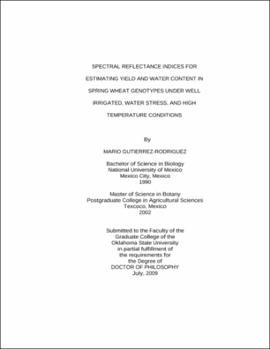| dc.contributor.advisor | Klatt, Arthur R. | |
| dc.contributor.author | Gutierrez-Rodriguez, Mario | |
| dc.date.accessioned | 2013-12-10T18:04:34Z | |
| dc.date.available | 2013-12-10T18:04:34Z | |
| dc.date.issued | 2009-07 | |
| dc.identifier.uri | https://hdl.handle.net/11244/7730 | |
| dc.description.abstract | Scope and Method of Study: Alternative methods for selecting, detecting, and identifying higher yielding genotypes in wheat breading programs are important for obtaining major genetic gains. The water indices can be used as an indirect selection tool because of their strong association with different physiological and yield components. Diverse spring wheat advanced lines were used, which corresponded to three international trials developed by the International Maize and Wheat Improvement Center (CIMMYT); 24th Elite Spring Wheat Yield Trial (ESWYT) with 25 lines, 11th Semi-Arid Wheat Yield Trial (HTWYT) with 18 lines. Two other experiments also employed advanced lines for testing the relationship between water indices and water content parameters (10-16 lines) and for evaluating the influence of morphological traits (20 lines) over the water indices. Several water indices and other reflectance indices were estimated at three growth stages (booting, heading, and grain filling) using a field portable spectrometer (Analytical Spectral Devices, Boulder, CO). Field plots were planted in Northwest Mexico during three growing seasons (2006, 2007, and 2007). Grain yield, biomass, and some water status parameters were determined in diverse experiments. | |
| dc.description.abstract | Findings and Conclusions: There were high correlations (phenotypic and genetic) between grain yield and the water indices showing high heritability, response to selection and correlated response, relative selection efficiency, and efficiency in selecting the higher yielding genotypes. Two water indices showed the strongest relationships (NWI-1 and NWI-3) for all the parameters determined in the well irrigated, water stress, and high temperature environments. In addition, the water indices were related with parameters commonly employed for assessing the crop water status (i.e., water potential) during booting, a thesis and grain filling under water stress conditions. Finally, our results demonstrated that the relationship between the water indices and grain yield was affected mainly by erect leaves and spike orientation. The potential for employing the water indices for selecting high yielding lines represents a significant advantage in breeding programs because the top yielding lines can be selected in an accurate, inexpensive, and easy manner. In addition, the best high yielding lines maintained high canopy water content under water stress conditions. | |
| dc.format | application/pdf | |
| dc.language | en_US | |
| dc.rights | Copyright is held by the author who has granted the Oklahoma State University Library the non-exclusive right to share this material in its institutional repository. Contact Digital Library Services at lib-dls@okstate.edu or 405-744-9161 for the permission policy on the use, reproduction or distribution of this material. | |
| dc.title | Spectral reflectance indices for estimating yield and water content in spring wheat genotypes under well irrigated, water stress, and high temperature conditions | |
| dc.contributor.committeeMember | Reynolds, Matthew P. | |
| dc.contributor.committeeMember | Raun, William R. | |
| dc.contributor.committeeMember | Stone, Marvin L. | |
| osu.filename | GutierrezRodriguez_okstate_0664D_10347.pdf | |
| osu.accesstype | Open Access | |
| dc.type.genre | Dissertation | |
| dc.type.material | Text | |
| dc.subject.keywords | breeding | |
| dc.subject.keywords | canopy reflectance | |
| dc.subject.keywords | indirect selection | |
| dc.subject.keywords | triticum aestivum | |
| dc.subject.keywords | water content | |
| dc.subject.keywords | yield performance | |
| thesis.degree.discipline | Crop Science | |
| thesis.degree.grantor | Oklahoma State University | |
